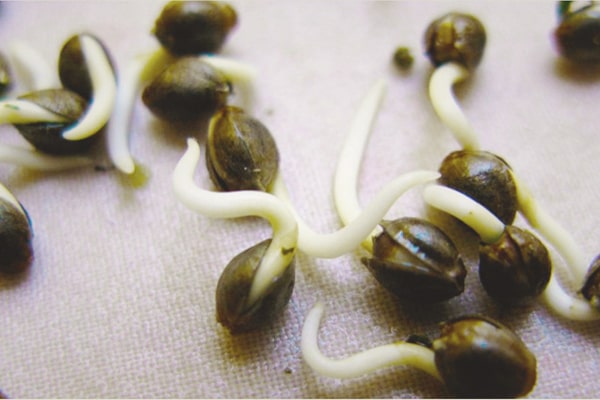
Germination, i.e. the return to active life of seeds in a state of quiescence, is the first phase to face if you want to start a cannabis crop.
There are many more or less efficient methodologies to allow the embryo contained in the seed to come to life, and in this guide we will list some of them.
The birth of the seed is a very important and not to be underestimated phase, since if a sprout comes to life to its full potential it will have more chance of becoming a strong, healthy and resistant plant.
Otherwise, if it were to have problems or stress during birth, the plant could experience problems such as slowing down in growth, greater exposure to diseases and pests, and obviously less abundant production.

Whichever germination method you choose there are some constants to follow:
The water used for this phase must have a PH ranging from 6.0 to 6.2, and must be mixed with 10% of the recommended dosage of specific products for the roots (Example: BioBizz Root Juice, Canna Rhizotonic, etc.).
Temperatures above 25 degrees will ensure that the seed is born faster, but you must ensure that the seed neither dries nor is drowned in too much water.
Once the seed is born, it will need a sufficient amount of light to allow it to grow without reaching out in search of light, but without burning due to excessive lighting.
When the first two leaves have opened, also called cotyledons, it will be necessary to irrigate with water and fertilizer for roots (With the minimum quantity recommended by the producer) making sure that the PH is between 6.0 and 6.2 and with an EC at 0.8, increasing the EC at 1.0 just ahead.
La germinazione, ovvero il ritorno alla vita attiva di semenze in stato di quiescenza, è la prima fase da affrontare se si vuole iniziare una coltura di cannabis.
Ci sono tante metodologie più o meno efficienti per permettere all’embrione contenuto nel seme di prendere vita, e in questa guida ve ne elencheremo alcune.
La nascita del seme è una fase molto importante e da non sottovalutare, poiché se un germoglio prende vita al pieno delle sue potenzialità avrà più possibilità di diventare una pianta forte, sana e resistente.
In caso contrario, se dovesse avere problemi o stress durante la nascita, la pianta potrebbe riscontrare problemi come rallentamento nella crescita, maggior esposizione a malattie e parassiti, e ovviamente una produzione meno abbondante.

Qualunque metodo di germinazione voi scegliate ci sono alcune costanti da seguire:
L’acqua usata per questa fase deve avere un PH che va dal 6.0 al 6.2, e deve essere miscelata con un 10% del dosaggio consigliato di prodotti specifici per le radici (Esempio: Root Juice di BioBizz, Rhizotonic di Canna ecc.).
Le temperature al di sopra dei 25 gradi faranno in modo che il seme nasca più velocemente, ma bisogna fare in modo che il seme né si secchi, né sia affogato in troppa acqua.U
Una volta nato il seme avrà bisogno di una sufficiente quantità di luce per permettergli di crescere senza allungarsi alla ricerca della luce, ma senza bruciarsi per l’eccessiva illuminazione.
Quando si saranno aperte le prime due foglie, anche dette cotiledoni, bisognerà irrigare con acqua e concime per radici (Con la quantità minima consigliata dal produttore) facendo attenzione che il PH sia tra 6.0 e 6.2 e con un EC a 0.8, aumentando l’EC a 1.0 poco più avanti.
La germinación, es decir, el retorno a la vida activa de las semillas en un estado de reposo, es la primera fase a enfrentar si desea comenzar una cosecha de cannabis.
Existen muchas metodologías más o menos eficientes para permitir que el embrión contenido en la semilla cobre vida, y en esta guía enumeraremos algunas de ellas.
El nacimiento de la semilla es una fase muy importante y que no debe subestimarse, ya que si un brote cobra vida a su máximo potencial, tendrá más posibilidades de convertirse en una planta fuerte, sana y resistente.
De lo contrario, si tuviera problemas o estrés durante el parto, la planta podría experimentar problemas como la desaceleración del crecimiento, una mayor exposición a enfermedades y plagas y, obviamente, una producción menos abundante.

Cualquiera que sea el método de germinación que elija, hay algunas constantes a seguir:
El agua utilizada para esta fase debe tener un pH que varía de 6.0 a 6.2, y debe mezclarse con el 10% de la dosis recomendada de productos específicos para las raíces (Ejemplo: BioBizz Root Juice, Canna Rhizotonic, etc.).
Las temperaturas superiores a 25 grados asegurarán que la semilla nazca más rápido, pero debe asegurarse de que la semilla no se seque ni se ahogue en demasiada agua.
Una vez que nazca la semilla, necesitará una cantidad suficiente de luz para que pueda crecer sin alcanzar la luz, pero sin quemar debido a la iluminación excesiva. Cuando se hayan abierto las dos primeras hojas, también llamadas cotiledones, será necesario regar con agua y fertilizante para las raíces (con la cantidad mínima recomendada por el productor) asegurándose de que el pH esté entre 6.0 y 6.2 y con un CE a 0.8, aumentando el EC en 1.0 justo por delante.